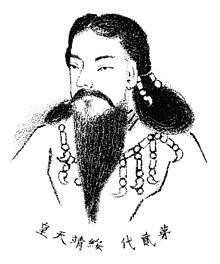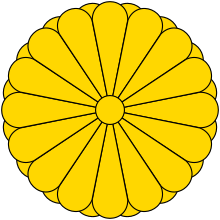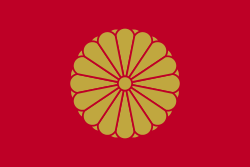Emperor Suizei
Emperor Suizei (綏靖天皇, Suizei-tennō[lower-alpha 1]), also known as Kamununakawamimi no Mikoto (神沼河耳命), was the second Emperor of Japan according to the traditional order of succession.[4][5] Very little is known about this Emperor due to a lack of material available for further verification and study. Suizei is known as a "legendary emperor" among historians as his actual existence is disputed. A legendary account from the Kojiki states that Suizei became emperor after receiving the title of crown prince by his half brother due to his bravery regarding a murder plot. Suizei's reign started in 581 BC, he had one wife and a sole son who supposedly became the next emperor upon his death in 549 BC.
| Suizei | |
|---|---|
 Picture of Suizei | |
| Emperor of Japan | |
| Reign | 581 BC – 549 BC (traditional)[1] |
| Predecessor | Jimmu |
| Successor | Annei |
| Born | 632 BC[2] |
| Died | 549 BC (aged 83) |
| Burial | Tsukida no oka no e no misasagi (桃花鳥田丘上陵) (Kashihara) (legendary) |
| Spouse | Isuzuyori-hime |
| Issue | Emperor Annei |
| House | Imperial House of Japan |
| Father | Emperor Jimmu |
| Mother | Himetataraisuzu-hime |
| Religion | Shinto |
Legendary narrative
While the Kojiki provides little information about Suizei, it does state his name, genealogy, and a record about his accession to the throne. He was born sometime in 632 BC, and was one of the sons of Emperor Jimmu and his chief wife Himetataraisuzu-hime.[2][6] The account in the Kojiki states that Suizei's older brother Kamuyaimimi was originally the Crown-prince. When Jimmu died, another of his sons named Tagishimimi attempted to seize the throne by murdering those in his way. Tagishimimi was given birth to by a lesser wife named Ahiratsu-hime, and was older than Jimmu's legitimate heir. When Himetataraisuzu-hime learned of the plot she tried in vain to warn her sons by way of songs and poems.[7] While Suizei encouraged Kamuyaimimi to slay Tagishimimi, he could not find it in him to murder his own half brother. Suizei pleaded with his older brother for the weapon he was going to use, and upon receiving it accomplished the deed for him. Kamuyawimimi ceded his rights as crown prince shortly after to Suizei as he believed his braver younger brother should be the new Emperor.[8]
Emperor Suizei's pre-ascension name remains unknown, but the Kojiki records that he ruled from the palace of Takaoka-no-miya (葛城高岡宮)[lower-alpha 2] at Katsuragi in what would come to be known as Yamato Province.[6] While another more expansive account exists in the Nihon Shoki, the section is more steeped in myth. Suizei is conventionally considered to have reigned from 581 to 549 BC.[6][9] He wed Isuzuyori-hime (五十鈴依媛命) at an unknown date, and the two had one son. Emperor Suizei allegedly died in 549 BC and his gravesite is formally named Tsukida no oka no e no misasagi.[5] He was succeeded by his only son, Prince Shikitsuhikotamatemi who became Emperor Annei.
Known information
The existence of at least the first nine Emperors is disputed due to insufficient material available for further verification and study.[10] Suizei is thus regarded by historians as a "legendary Emperor", and is ranked as the first of eight Emperors without specific legends associated with them.[lower-alpha 3] The name Suizei-tennō was assigned to him posthumously by later generations, and literally means "joyfully healthy peace".[12] His name might have been regularized centuries after the lifetime ascribed to Suizei, possibly during the time in which legends about the origins of the Yamato dynasty were compiled as the chronicles known today as the Kojiki.[11] While the actual site of his grave is not known, an Imperial misasagi or tomb for Suizei is currently maintained in Kashihara.[4] The first emperor that historians state might have actually existed is Emperor Sujin, the 10th emperor of Japan.[13] Outside of the Kojiki, the reign of Emperor Kinmei[lower-alpha 4] (c. 509 – 571 AD) is the first for which contemporary historiography is able to assign verifiable dates.[16] The conventionally accepted names and dates of the early Emperors were not confirmed as "traditional" though, until the reign of Emperor Kanmu[lower-alpha 5] between 737 and 806 AD.[11]
Consorts and Children
- Empress: Isuzuyori-hime (五十鈴依媛命), Kotoshironushi's daughter
- Prince Shikitsuhikotamatemi (磯城津彦玉手看尊), later Emperor Annei
See also
- Emperor of Japan
- List of Emperors of Japan
- Imperial cult
Notes
- Sometimes romanized as Suisei[3]
- In the Nihon Shoki as 葛城高丘宮
- Also known as the "eight undocumented monarchs" (欠史八代, Kesshi-hachidai).[11]
- The 29th Emperor[14][15]
- Kanmu was the 50th sovereign of the Yamato dynasty
References

- ""Genealogy of the Emperors of Japan"" (PDF). Kunaicho.go.jp. Retrieved May 7, 2019.
- Kenneth Henshall (2013). Historical Dictionary of Japan to 1945. Scarecrow Press. p. 487.
- Nussbaum, Louis-Frédéric (2002). Japan Encyclopedia. Harvard University Press. p. 32.
successor to Suisei Tennō
- "綏靖天皇 (2)". Imperial Household Agency (Kunaichō) (in Japanese). Retrieved May 7, 2019.
- Ponsonby-Fane, Richard (1959). The Imperial House of Japan. Ponsonby Memorial Society. p. 29 & 418.
- Brown, Delmer M. and Ichirō Ishida (1979). A Translation and Study of the Gukanshō, an Interpretative History of Japan Written in 1219. University of California Press. pp. 250–251.
- Norinaga Motoori (2007). The Poetics of Motoori Norinaga: A Hermeneutical Journey. University of Hawaii Press. p. 191. ISBN 978-0-8248-3078-6.
- Chamberlain, Basil. The Kojiki. Read before the Asiatic Society of Japan on April 12, May 10, and June 21, 1882, reprinted in 1919. p. 184.
- Titsingh, Isaac. (1834). Nihon Ōdai Ichiran (in French). Royal Asiatic Society, Oriental Translation Fund of Great Britain and Ireland. p. 3.
- Kelly, Charles F. ""Kofun Culture"". www.t-net.ne.jp. Retrieved May 7, 2019.
- Aston, William George. (1896). Nihongi: Chronicles of Japan from the Earliest Times to A.D. 697, Volume 2. The Japan Society London. pp. 109, 138–141.
- Brinkley, Frank (1915). A History of the Japanese People from the Earliest Times to the end of the Meiji Era. Encyclopaedia Britannica Company. p. 21.
Posthumous names for the earthly Mikados were invented in the reign of Emperor Kanmu (782–805), i.e., after the date of the compilation of the Records and the Chronicles.
- Yoshida, Reiji. (March 27, 2007). ""Life in the Cloudy Imperial Fishbowl"". Japan Times. Retrieved May 7, 2019.
- Titsingh, Isaac. (1834). Nihon Ōdai Ichiran (in French). Royal Asiatic Society, Oriental Translation Fund of Great Britain and Ireland. pp. 34–36.
- Brown, Delmer M. and Ichirō Ishida (1979). A Translation and Study of the Gukanshō, an Interpretative History of Japan Written in 1219. University of California Press. pp. 261–262.
- Hoye, Timothy. (1999). Japanese Politics: Fixed and Floating Worlds. Prentice Hall. p. 78.
According to legend, the first Japanese Emperor was Jimmu. Along with the next 13 Emperors, Jimmu is not considered an actual, historical figure. Historically verifiable Emperors of Japan date from the early sixth century with Kimmei.
Further reading
- Aston, William George. (1896). Nihongi: Chronicles of Japan from the Earliest Times to A.D. 697. London: Kegan Paul, Trench, Trubner. OCLC 448337491
- Brown, Delmer M. and Ichirō Ishida, eds. (1979). Gukanshō: The Future and the Past. Berkeley: University of California Press. ISBN 978-0-520-03460-0; OCLC 251325323
- Chamberlain, Basil Hall. (1920). The Kojiki. Read before the Asiatic Society of Japan on April 12, May 10, and June 21, 1882; reprinted, May, 1919. OCLC 1882339
- Nussbaum, Louis-Frédéric and Käthe Roth. (2005). Japan encyclopedia. Cambridge: Harvard University Press. ISBN 978-0-674-01753-5; OCLC 58053128
- Ponsonby-Fane, Richard Arthur Brabazon. (1959). The Imperial House of Japan. Kyoto: Ponsonby Memorial Society. OCLC 194887
- Titsingh, Isaac. (1834). Nihon Ōdai Ichiran; ou, Annales des empereurs du Japon. Paris: Royal Asiatic Society, Oriental Translation Fund of Great Britain and Ireland. OCLC 5850691
- Varley, H. Paul. (1980). Jinnō Shōtōki: A Chronicle of Gods and Sovereigns. New York: Columbia University Press. ISBN 978-0-231-04940-5; OCLC 59145842
| Regnal titles | ||
|---|---|---|
| Preceded by Emperor Jimmu |
Legendary Emperor of Japan 581 BC – 549 BC (traditional dates) |
Succeeded by Emperor Annei |
